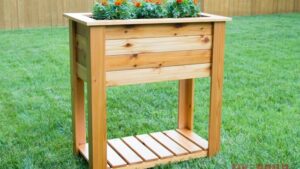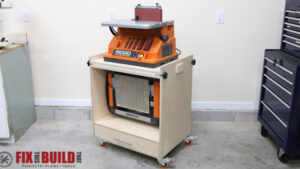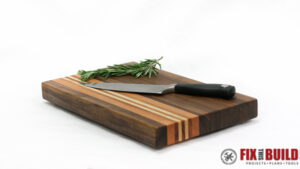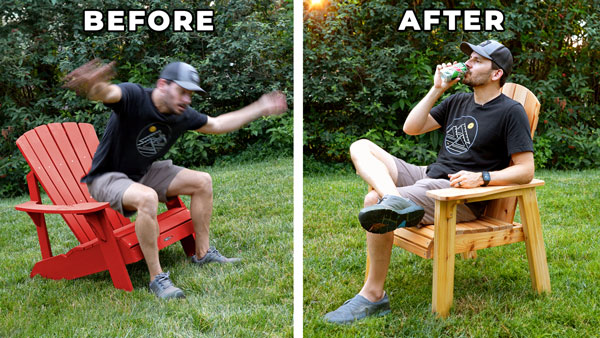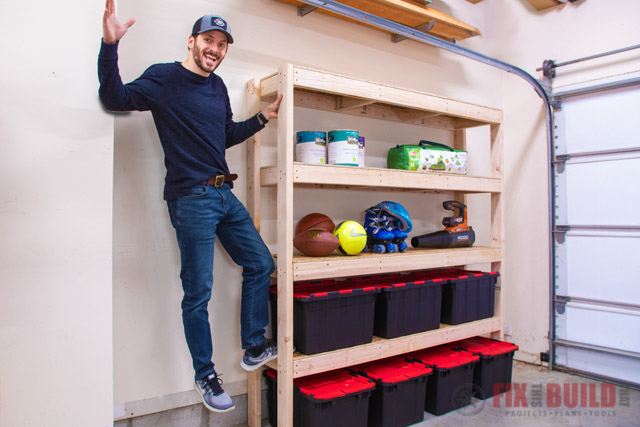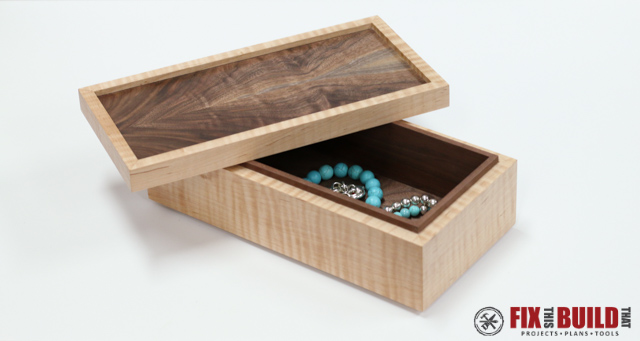
Is your closet an unorganized mess? Do you have wasted space and stuff shoved everywhere? I feel your pain. My son’s closet was a hot mess with wasted space and years worth of “treasures” shoved everywhere. It was time to fix this mess with my DIY Closet Organizer with Shelves and Drawers.
This DIY Closet Organizer is the perfect way to gain extra storage from your closet. It has a built-in center dresser with four drawers and a hutch with adjustable shelves. Hanging storage and more shelves are added to the left and right and can be configured for short or long hanging spaces.
The closet organizer stands 84” tall with the center portion 25-14” wide and 19-3/4” deep. The hanging spaces can be fit for your specific closet. This unit as shown was made from 3 sheets of ¾” plywood and a half sheet of ¼”
Materials/Supplies
- (3) 4’x8′ 3/4″ Plywood
- (1)4’x4′ 1/4″ Plywood
- (2) 1”x2” 8’ Poplar
- (4 pair) 18″ Drawer Slides
- (4) drawer/door pulls
- (8) hanging rod brackets
- (4) hanging rods
- 1-1/4″ pocket screws
- 1-1/4″ wood screws
- (12) 1/4″ shelf pins
Affiliate links are used on this page. See my disclosure page for info on affiliate programs.
How to Build DIY Closet Shelving
- Remove old wire shelving
- Build cabinet base
- Make and install drawers
- Build the hutch
- Add drawer fronts and prep long shelves
- Install the closet organizer
1. Remove Old Wire Shelving
Empty Out Closet
To get started we removed the clothes, hangers and everything else from the closet. After that was done we were ready for the first real job, taking out all of the wire shelving. Resist the urge to just rip your wire shelving out of the wall, you’ll wind up with huge holes all over the place that you’ll need to patch and fill. Believe me, it’s a pain.
The good news is removing wire shelving is easy to do. And I’ll walk you through the process step-by-step.
Remove Vertical and Angled Supports
If your closet has a vertical support you’ll need to remove them first by unscrewing the clips. The shelves are attached to the wall by a series of clips and brackets, start by removing the angled supports.
And here’s a trick for easy removal. Use a pair of pliers to grip the nail head and pull it out. Then you can do the same thing to the wall anchor and since the nail isn’t there expanding it anymore it will come out cleanly.
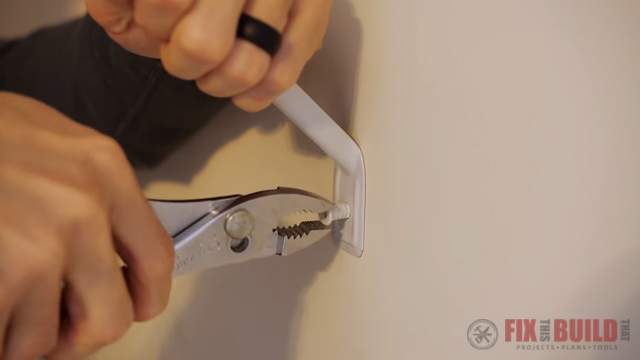

Remove Clips and Wire Shelves
Remove any clips that are screwed into studs then you should just be left with the open J-style clips along the back. You can pop the wire shelving out of these clips with a few quick pulls or a mallet.
Remove J-Clips
The j-clips are a little trickier since you can’t just grab the nail head. So use a putty knife or screwdriver to pry the nail out of the recess first.
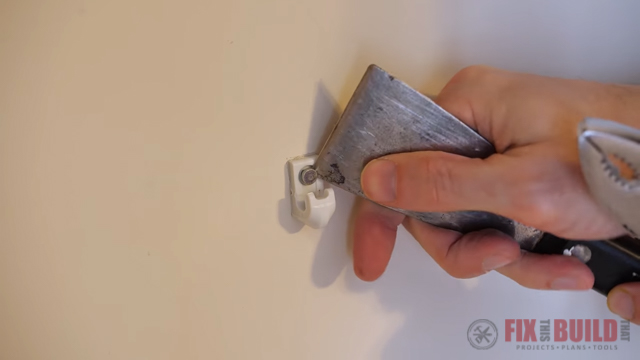

Then you can grab the nail and remove the wall anchors.
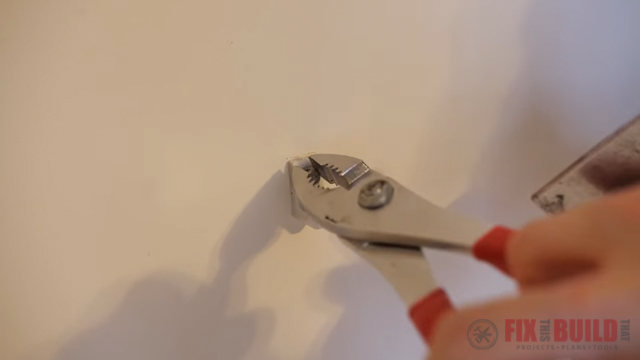

After you’re done you should just need to do a little patching and sanding to get the wall prepped afterwards.
2. Build Cabinet Base of DIY Closet Shelves
Break Down Plywood and Cut Parts
I started by breaking down my large sheets of plywood to make them more manageable. I used my track saw and some rigid foam insulation on top of my table saw and new outfeed table.
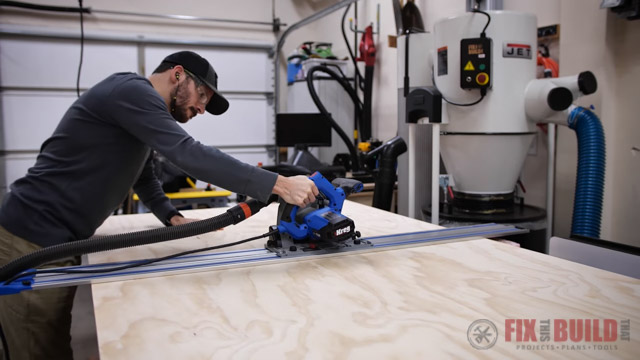

You could make the rest of the cuts with a circular saw, but if you have a table saw it would be much easier to use.
The base of the center unit will have four drawers and will function like a small dresser. I cut the parts for the carcass then took the sides to my bench for some notches.
Make Cuts for Toe Kick and Baseboards
I made layout lines for a toe kick on the front of the dresser, and used my jigsaw to cut them out.
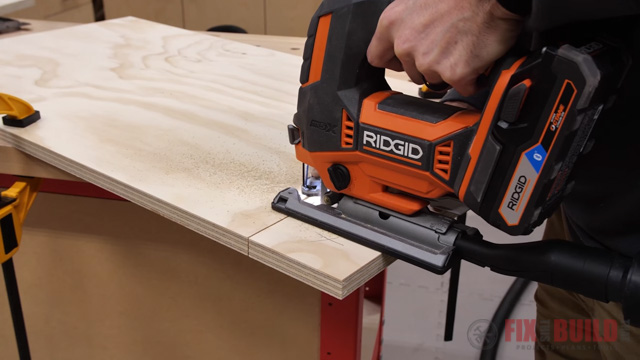

I also decided to cut a notch on the back of the board to go around the baseboards. This allows me to be able to leave the baseboards in place.
Attach Sides of Cabinet Base
The sides are joined by the bottom and four supports. I cut the parts to size then used my new Kreg K5 for joinery.
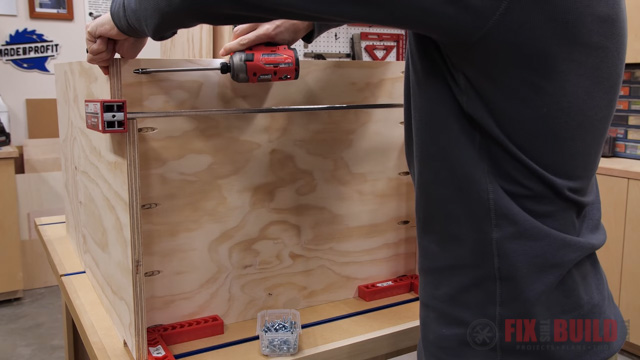

Next I secured the bottom with pocket screws. Then I flipped the cabinet over and secured the top supports as well using large clamps to hold everything tight.
The back supports got attached to the sides and I also put two screws through the top and bottom to hold them in place as well. This prevents bowing and separation when they are secured to the wall.
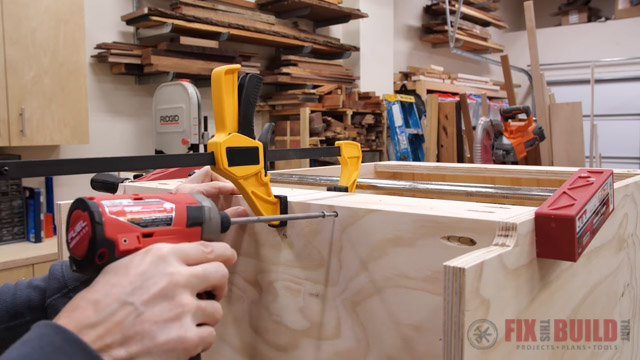

3. Build and Install Drawers
Build Drawers
We decided to go with four medium sized drawers. I cut the parts to size to account for the full extension drawer slides I’ll be using. For more information on how I build my drawers check out How To Make Drawers in 6 Easy Steps. The drawers go together with pocket screws which hold well in the 3⁄4” plywood. After the boxes were together I cut four drawer bottoms from 1⁄4” plywood. I glued and nailed the bottoms in place and this makes the drawer even stronger as it locks everything together.


I finished out each drawer by routing a 45 degree chamfer on the edges. This hides the plywood bottom when viewed from the side and gives it a floating panel look.
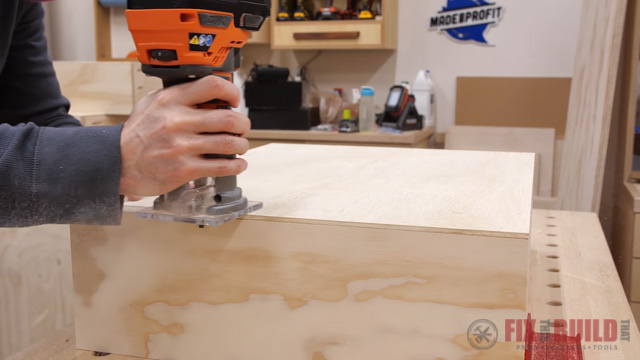

Before installing the drawers I needed to do one more thing. I put a couple coats of white paint on the first several inches of the inside of the cabinet, which is all you’ll ever see in use.
Add Drawer Slides
After the paint was dry I installed the full extension slides using a small spacer for the bottom slide. Then I used an offcut of the drawer parts to space the rest of the slides as I attached them up both sides.


With the slides in place I could put the drawers in and attach them to the slides right there in the cabinet.
Build Cabinet Base Top
Next I cut the top for the cabinet base along with the drawer fronts. I’m using a plywood top with a solid wood trim on the front to give it a more custom look. I used the panel to mark the length of the trim and cut it to size to fit.
Next I attached the trim with pocket screws but you could also glue and nail it in place as well.


Before moving to the hutch I put a coat of paint on the cabinet and top so it could be drying why I build.
4. Build the Hutch
Cut Parts for Hutch
The hutch is just under four feet tall so I cut a full length section in half with my track saw.
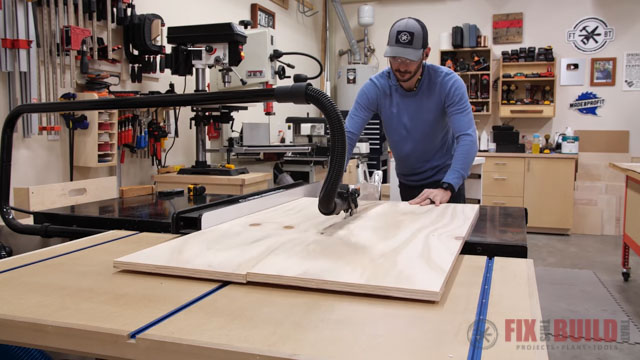

Then I ripped the sides down. Next I went ahead and rough cut the parts for the top, the back supports and the three adjustable shelves that will go in the hutch.
Next I pulled out Fred the Sled to cut all the parts to final length. I cut the top and the shelves to final size as well. They ended up just longer than my sled so I had to mark and cut them instead of using the stop block.
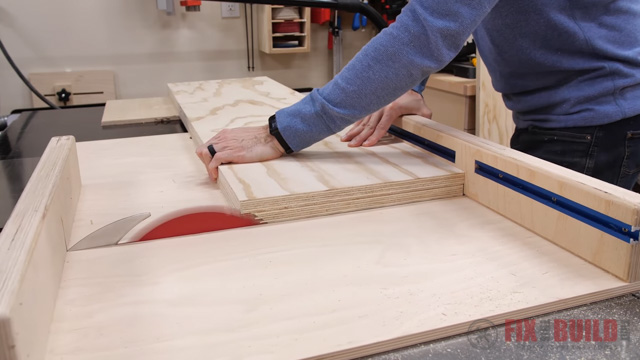

Attach Support Pieces
The supports for the hutch are similar to the ones on the cabinet. They’ll be attached with pocket holes along with the top piece. These will all be facing the top or back of the closet so you won’t need to plug them for painting.
Drill Holes for Adjustable Shelves
You could make fixed shelves for the hutch, but I much prefer adjustable shelves.
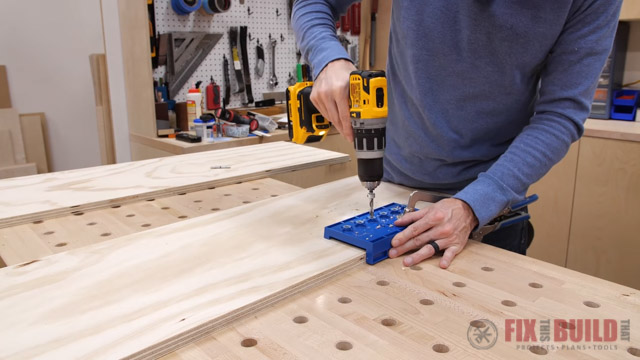

After drilling the shelf pin holes I painted the sides and the top before assembly. It’s way easier to roll the parts as panels vs working into corners.
Screw and Clamp Hutch Carcass
When they were dry I clamped the top between the sides and secured it with pocket screws. And because the paint wasn’t fully cured just yet I used wax paper between it and the clamp heads. This keeps the clamps from sticking to the sides under pressure or embedding any small wood chips into the finish.


I added one back support to the top of the hutch, securing it to the top panel as well. And I put another right at the bottom. The weight of the hutch will transfer to the base cabinet, but you still want to secure it tightly to the wall through these pieces.
Add Wood Trim to Hutch
I wanted to add a little visual heft to the hutch so I used more poplar trim for a face frame. I cut the top trim so it overhung on each side then I attached it to the hutch with glue and brad nails.
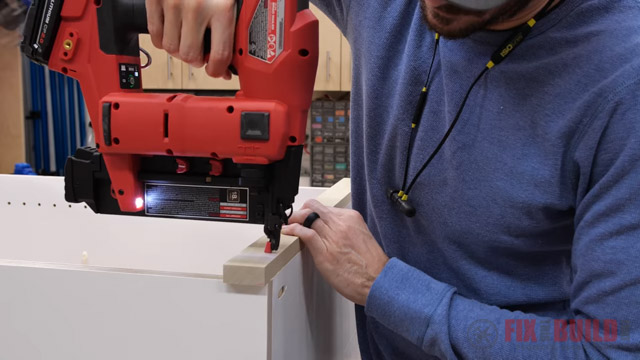

Then I used a longer piece of trim and marked it and cut it to length to fit the side of the hutch.
I used a combination square to measure and set the distance between the top trim piece and the side panel. Then I could use that setup to evenly space the trim down the length of the panel.
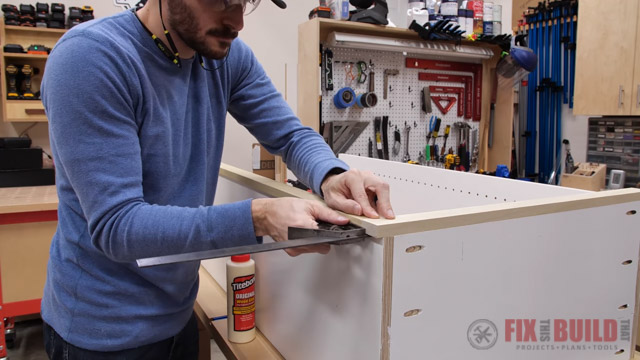

The nails leave a little divot which I filled with wood putty then painted the trim to match the hutch.
Add Wooden Dowel
When I finished making the hutch I put it on top of the cabinet drawer base to see how it looked. Then I realized the front of the base wasn’t secured to the base cabinet. I decided to connect the front of the hutch with the cabinet base by adding a dowel to each side. You can get more information on how I did this in the video or in the plans.


5. Add Drawer Fronts and Prep Long Shelves
Attach Cabinet Top and Drawer Fronts
Next I switched back to finish up the cabinet. The top gets attached from underneath then I could mount the drawer fronts. I drilled the holes for the hardware I’ll be using and these holes will let me easily space and mount the fronts.
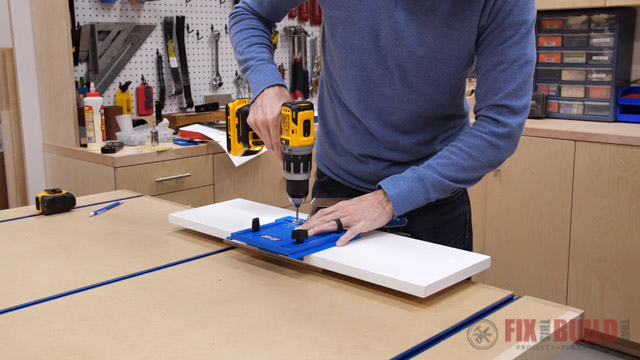

Typically I start from the bottom, but since the top trim is flush I wanted to make sure and nail that reveal line first and then work down from there. I used an 1⁄8” spacer on top of the drawer front then screwed the front to the drawer box temporarily with pocket screws.
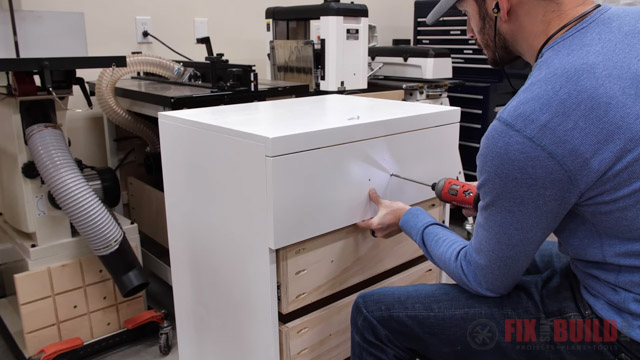

With it held in place I could open the drawer without the front moving and permanently secure it from the inside through some holes I’d drilled earlier in the drawer box.
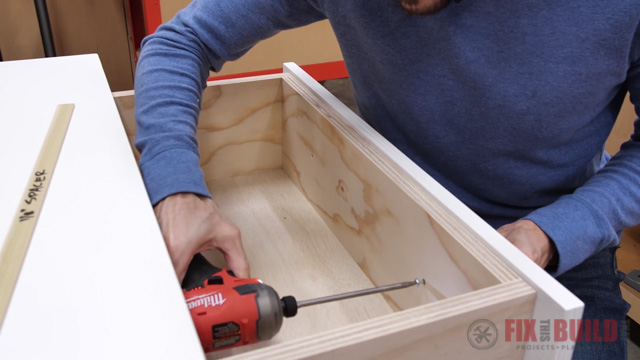

To finish it off I removed the front screws, drilled all the way through the drawer box and installed the drawer pulls.
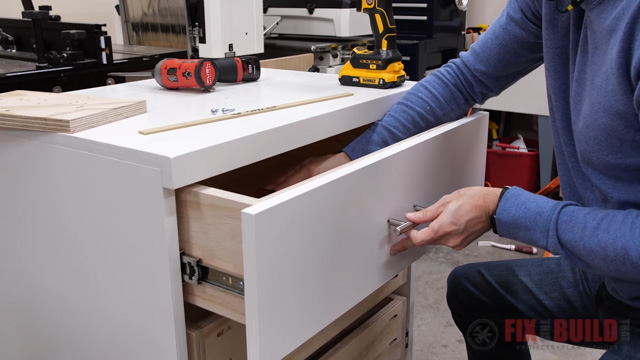

Cut Long Shelves to Length
Finally I cut all of the wood for the long shelves in the closet organizer. I cut the wood for each shelf, along with the support pieces that I’ll use to mount the shelves. Then I cut the rods to length and painted all of the pieces.
6. Install the DIY Closet Shelves
Install DIY Cabinet Base
Next I installed the base cabinet, which went fairly smoothly. I didn’t have to remove the baseboards since I allowed for them when building the cabinet. I did have to use wall anchors however because apparently 32” on center studs is a thing in this closet. But the hutch was a whole different story.
Install Hutch
When I tried to install the hutch I realized there was a sizable hump in the wall right where the hutch needed to go. To fix this, I had to scribe the side panel so I could adjust it to make it fit flush. I did this by using a compass to match the largest gap and running it along the edge of the hutch to show where I needed to remove material.
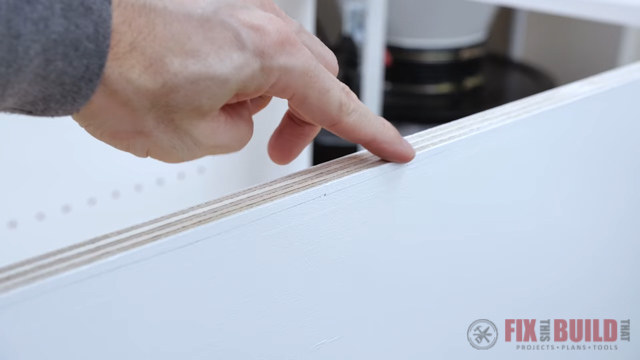

Then I took the hutch to the shop and sanded to the line with my belt sander. When I brought it back upstairs it wasn’t a perfect fit but it was good enough to line up the dowel pin holes and be flush to the back wall. After leveling the unit I secured the hutch to the wall again using anchors.
Install Long Shelves and Hanging Rods
Finally I could attach the upper and middle shelves using a cleat on the hutch, back wall and the side wall. I made the top shelf flush with the top of the hutch for a continuous upper shelf.
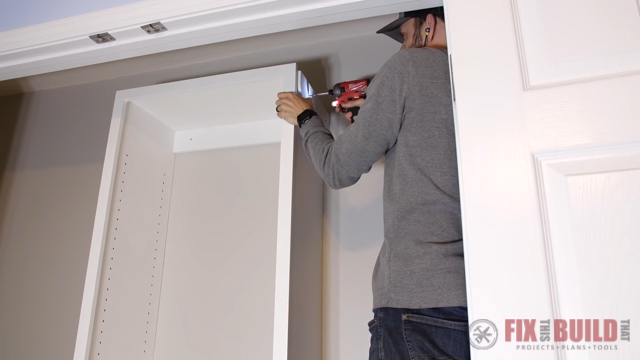

We decided to go with two bays of short hanging space on each side of the hutch since my son doesn’t need long hanging. However if you need long hanging space or a place for your shoes you could easily remove the lower shelf on one side.
Next I installed some brackets to hold metal rods and then cut the metal rods to size to fit. There are several different types of hanging rods out there but these were inexpensive and have a clean look.
And that’s how I made the DIY Closet Organizer with Shelves and Drawers. This project was a game changer in my son’s room. He his closet has so much storage he has no excuse if his room is messy!
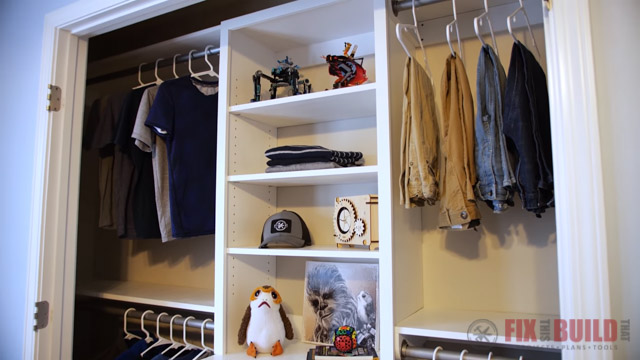

If you’re looking for more DIY projects you’ve come to the right place. Check out my Home DIY Projects for more builds and projects you can use to transform your home.






